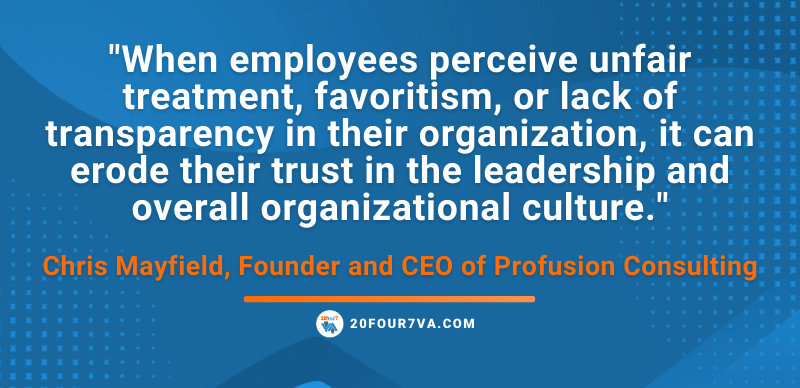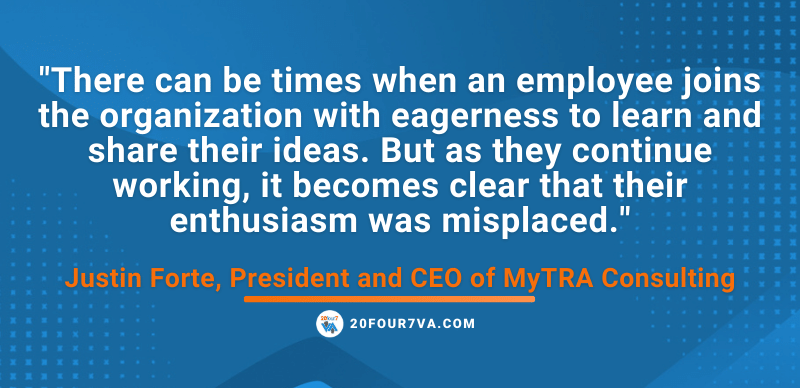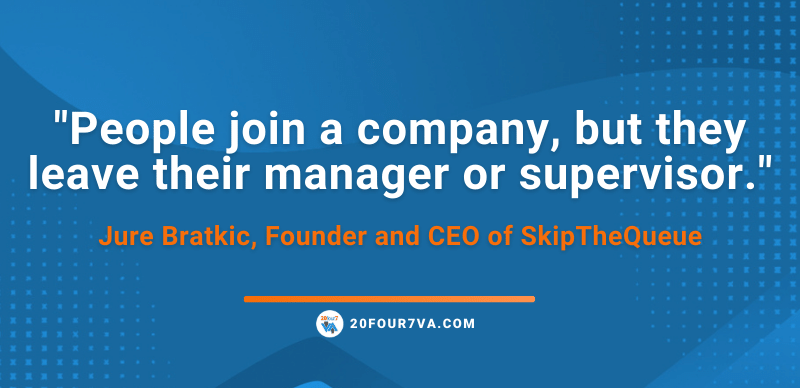How to Keep Employees Engaged in the Era of Quiet Quitting

By now, you’re probably familiar with the term “quiet quitting,” the buzzword that has infiltrated business news headlines and social media reels. Quiet quitting means delivering the minimum requirements of the job. A worker who is quiet quitting does not put in more time, effort, or enthusiasm than what is necessary. If workers are quiet quitting, you can bet that they’re unsatisfied with their jobs, burnt out, or disengaged.
We can attribute the rise of quiet quitting to various factors, from external (changing work and economic landscapes) to internal (lackluster company culture). But one thing that employers can control is having a solid employee engagement strategy. Keeping employees engaged can see organizations through the era of quiet quitting.
We reached out to top CEOs and business consultants to help us learn more about how to keep employees from quitting.
What are the Top Reasons for Quiet Quitting?
Before we dive into finding the best employee engagement practices, let’s take a moment to understand what we’re dealing with. We need to figure out what’s causing that feeling of quiet disengagement among our workforce before we can start brainstorming solutions to bring back their enthusiasm.
These are some of the most common reasons workers resort to quiet quitting:
1. Lack of Trust in Leadership
Managers play a critical role in shaping employees’ overall job satisfaction and commitment to an organization. Jure Bratkic of SkipTheQueue puts it simply, “People join a company, but they leave their manager or supervisor.”
One of the significant ways leaders lose their employees’ trust is when there’s a lack of transparency. Things like unclear standards for promotion and performance evaluation can discourage any employee. Other factors can also cause this lack of trust, from poor communication to a perceived lack of empathy from leadership.
2. Disengagement and Disillusionment
Employees don’t wake up one day and feel wholly disengaged and disillusioned with their jobs. Here are some of the ways that can cause disengagement and disillusionment:
-
Overpromising and Underdelivering
Unmet expectations can make employees lose trust in their manager and the company. It can also decrease motivation and productivity as employees become skeptical of what leadership tells them. An example is when a manager makes a promise they cannot fulfill, such as a promotion or a raise, and then fails to follow through.
-
Unconscious Bias
“When employees perceive unfair treatment, favoritism, or lack of transparency in their organization, it can erode their trust in the leadership and overall organizational culture,” says Chris Mayfield, Founder and CEO of Profusion Consulting. He adds, “As a result, employees may resort to quiet quitting as a coping mechanism, choosing to disengage from their job without formally resigning.”
It’s clear that when there’s unconscious bias in the workplace, it can affect various aspects of the organization. And it starts with the recruitment process. Unconscious bias in talent acquisition can lead to a lack of diversity and inclusivity. This creates a domino effect where employees feel like they do not belong and even experience microaggressions in the workplace.

-
Lack of Challenging Work and Growth Opportunities
When employees aren’t provided with challenging work, they can experience boredom and a sense of stagnation. This is particularly true for individuals who thrive on fresh challenges and continuous learning opportunities. Consequently, this sense of monotony can lead to a state of demotivation, ultimately resulting in employee disengagement.
Another reason employees become disengaged is a lack of learning and growth opportunities. As Justin Forte, President and CEO of MyTRA Consulting, shared, “There can be times when an employee joins the organization with eagerness to learn and share their ideas. But as they continue working, it becomes clear that their enthusiasm was misplaced.”
This can be due to the employer needing to provide more opportunities for professional development. Or, it can be just a case of the wrong job fit. Either way, the employee ends up losing their passion for their work.
3. Economic Challenges
Financial stress has a significant impact, both consciously and subconsciously, on individuals. News about wage cuts, salary freezes, and even layoffs mean job insecurity for employees. This can lead to a feeling of being undervalued and underappreciated for their efforts. Consequently, these circumstances contribute to disengagement and lead to an increase in the number of “quiet quitters.”
Additionally, uncertainty about work and the economy places an immense burden on workers. This situation leaves them lacking the motivation and incentives to go the extra mile, despite their financial obligations. As a result, a “chicken and egg” scenario emerges where employees recognize their desire to leave but find themselves unable to resign due to their financial responsibilities. This predicament inevitably leads to quiet quitting as employees remain aware that they wish to move on but cannot afford to jeopardize their job security.
4. Poor Company Culture
When management fails to take the time to build a company culture that values employees, they can expect to have quiet quitters in their organization. A toxic work environment, lack of support, and poor leadership will eventually cause employee demotivation and distrust.
Business leaders must improve the company culture if they want to minimize or eliminate the effects of quiet quitting. It’s essential to have a work environment that rewards and recognizes top performers and, at the same time, supports underperforming employees.
For more remote talent management tips, read our article on how to help underperformers before it’s too late. Or, schedule a free, no-obligation discovery call with our Growth Experts today!
5. Lack of Work-Life Balance
When a company culture fails to prioritize work-life balance, it can have detrimental effects. Viewing employees merely as cogs in a machine, devoid of their human emotions and relationships, creates a host of issues. The absence of empathy and guidance within the workplace sets the stage for unrealistic work expectations, extended working hours, and the development of unhealthy work habits.
There is a growing trend of younger workers no longer subscribing to the notion of the “hustle culture”—in fact, they actively reject it. For a significant portion of the workforce, quiet quitting is not synonymous with slacking off or underperforming; it is an attempt to evade corporate burnout. As leaders often lack the understanding of establishing healthy work-life boundaries, quiet quitting becomes an alternative means for employees to prioritize their well-being and strive for a better work-life balance.

Effects of Quiet Quitting
When observed in moderation, quiet quitting shouldn’t be a cause for concern. Instead, it can serve as a catalyst for reevaluating and shaping the desired company culture. However, when confronted with a workforce characterized by demotivation, disengagement, and disillusionment, it indicates a significant problem that needs immediate attention.
The effects of quiet quitting can be seen in the form of lower morale and productivity. It will also lead to a lack of enthusiasm and creativity among employees, which can cause your productivity to plateau or even decline. Additionally, it can weaken both internal and external relationships since all parties can feel the effects of unmotivated employees.
1. Decreased Productivity
As employees start to disengage and engage in “quiet quitting,” productivity tends to suffer, particularly when it involves top-performing individuals. Businesses face a decline in productivity when their valuable talents opt to do only the bare minimum.
Worse, demotivated employees may lose interest in pursuing growth opportunities and advancing up the corporate hierarchy. This places management in a challenging position and deprives them of the opportunity to nurture potential future business leaders.
2. Increased Employee Turnover
Inevitably, there will come a point where quiet quitters ultimately depart from the company, placing an additional burden on the remaining employees who must shoulder the abandoned workload. If this workload becomes overwhelming, it can lead to burnout and further instances of quiet quitting, perpetuating an unending cycle. The loss of experienced and skilled employees can significantly impact the company’s ability to achieve its business objectives and result in long-term decreases in productivity.
Quiet quitting not only affects the individual employee and their workload but also has a ripple effect on their colleagues. When fellow employees witness someone becoming demotivated and disengaged, they naturally question the underlying causes. They may also begin to harbor doubts about the company’s direction and their job security.
3. Negative Impact on Company Culture
Quiet quitting can have a profound and long-lasting negative impact on the company culture. When employees silently disengage, it can create an atmosphere of mistrust, dissatisfaction, and even hostility among co-workers. This will lead to less collaboration, fewer creative ideas, and a lack of motivation in the workplace. Additionally, quiet quitting fosters an environment of apathy, which can be detrimental to a company’s progress and growth.
Once you’ve observed quiet quitting in your workforce, inaction or band-aid solutions will only exacerbate the situation. While it may be difficult and time-consuming, management must address the factors within their control. One effective approach is to focus on keeping employees engaged, which can benefit both employees and the overall business.

What is Employee Engagement?
Employee engagement is a critical factor in keeping employees motivated and inspired. It’s the emotional connection and commitment that an employee has to their job, their workplace, and the organization they work for. When employees are fully engaged, they are fully immersed in their work, understand its importance, and are passionate about achieving the company’s goals.
Why work on employee engagement in the first place? The answer is simple. Employees who feel valued and appreciated tend to be more engaged, focused on their job, and less likely to resort to quiet quitting.
Employee Engagement Strategies That Actually Work in a Quiet Quitting World
Enhancing employee engagement requires a dedicated investment of time and patience. Leadership must wholeheartedly prioritize creating an environment where employees genuinely feel engaged, valued, and motivated.
Here is how to prevent quiet quitting:
1. Open and Transparent Communication
Chris Mayfield recommends establishing “open and transparent communication channels encouraging employees to share their thoughts, ideas, and concerns.” He adds, “Listening actively to employees’ feedback and addressing their problems promptly and respectfully can help employees feel heard and valued.”
To ensure open and effective communication channels in the workplace, consider implementing the following practices:
- Conduct regular team meetings to foster collaboration and teamwork.
- Organize town hall meetings to provide general company updates and promote transparency.
- Schedule one-on-one sessions for performance reviews and constructive feedback exchanges.
- Actively seek and value employee feedback to encourage their participation and involvement.
- Establish both synchronous and asynchronous communication platforms to accommodate different work styles and preferences.
- Maintain professionalism by being mindful of your tone and expressions in all communication interactions.
- Utilize collaboration and project management tools to ensure alignment and clarity among team members, regardless of their synchronous or asynchronous work arrangements.
While communication channels may vary across different organizations, one aspect remains constant: fostering a two-way conversation where both parties are open to listening and learning. Regardless of the specific platforms you utilize, prioritizing active engagement and receptiveness is key to effective communication.
Want to know more about the top communication tools for remote teams? Book a free consultation with our Growth Experts today!
2. Have an Effective Recognitions and Rewards System
“Employees are [a company’s] greatest asset,” says John G. Self, a recruitment expert and executive coaching professional. “They should be celebrated and compensated.”
Implementing a recognition and rewards system can be extremely helpful in keeping employees engaged in the era of quiet quitting. Acknowledging employees for their hard work, dedication, and achievements can make them feel valued and appreciated. This feeling of belonging can lead to increased morale, greater job satisfaction, and improved employee engagement.

Monetary rewards can take various forms, including bonuses, gift cards, and salary increases, among others. However, financial rewards must be coupled with public recognition, such as certificates, plaques, or company-wide announcements. Apart from ensuring that top-performing employees feel genuinely appreciated for their contributions to the company, public recognition fosters a sense of belonging. It can also serve as inspiration for others to strive for excellence, knowing that their hard work will be recognized and rewarded, rather than resulting in an increased workload.
3. Provide Opportunities for Growth and Development
It’s important to provide employees with the opportunity to grow and develop. This not only helps them become more competent in their respective roles but also keeps them engaged. Employees will feel that management values their personal development and are more likely to be more engaged and motivated at work.
Investing in training and development can also help organizations identify future leaders. They’ll see who responds well to learning opportunities and who has the potential to lead their own team. This way, employees will know that they have a place in the company’s future should they be willing to apply themselves.
4. Train Managers to be Leaders, Not Bosses
Kimberly Wiefling, the founder of Wiefling Consulting and Silicon Valley Alliances, says leadership is vital in motivating employees. She notes, “When employees are highly engaged, every measure of business success is positively impacted.”
A great starting point is to provide training to your managers, encouraging them to embrace leadership rather than a boss-like mentality. While both roles require specific skills, it’s essential to recognize the fundamental difference between being a leader and being a boss.
Leaders empower employees by granting them the freedom to act and make independent decisions, whereas bosses typically demand strict obedience without room for autonomy. Instead of being a boss that orders the team around, Kimberly recommends, “Managers should aim to be leaders that employees can admire and willingly follow.”
Effective and empathic managers can help your company in this era of quiet quitting. They work with employees directly, so they’re better positioned to identify the telltale signs of employees who are about to or already feel disengaged.

5. Prioritize Employee Well-Being
While it can be easy to get caught up in financial reports, bottom lines, revenues, and KPIs, it’s crucial to keep in mind that business success goes beyond numbers. Companies need to prioritize employee well-being. When employees are healthy and content, they are better positioned to make meaningful contributions to the team and overall company performance.
Physical and mental health issues contribute to reduced productivity and lack of motivation. Organizations must put in the effort to address these issues by creating an employee well-being program. This program should include the following:
- A comprehensive medical insurance package
- Access to counselors or therapists
- Regular stress management programs and activities
- Resources for mental health support
- Paid time off and sick days
- Flexible working arrangements
- Regular review of business and staffing requirements to maintain reasonable workloads
- Group wellness programs to promote healthy practices and establish connections between co-workers
- Establishing a positive work environment starting from leadership and across the organization
Offering these benefits demonstrates your genuine concern for your employees’ well-being, leading to improved morale and engagement. Furthermore, it is crucial to provide managers with proper training to identify signs of mental health issues among team members and equip them with the tools to offer the necessary support.
In the era of quiet quitting, where disengagement and demotivation can silently permeate the workforce, it has become increasingly vital for organizations to prioritize employee engagement.
By understanding the underlying causes and implementing effective strategies, companies can create a culture that nurtures and supports their employees. From fostering open communication channels to recognizing and valuing their contributions, investing in employee well-being and engagement not only boosts productivity but also cultivates a positive work environment where individuals thrive.
Embracing these practices is the key to retaining top talent, driving success, and building a resilient organization in the face of evolving workplace dynamics. By taking proactive steps to keep employees engaged, companies can pave the way for a brighter future where individuals are motivated, fulfilled, and committed to achieving shared goals.
Need tips on setting employees up for success? Our Business Growth Experts will be happy to share their top tips—and more!










